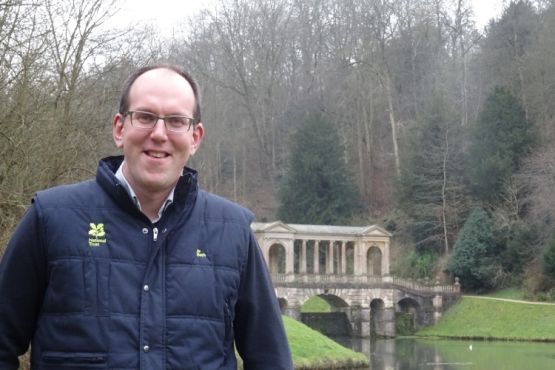An exciting new role for the Bath Assembly Rooms

As the management of Bath Assembly Rooms returns to the National Trust in 2023, plans are taking shape to transform the building and bring to life the hidden history of this significant venue. A new role – Experience and Visitor Programming Manager – has been created to head up the project. And Tom Boden, who’s General Manager for the Bath Portfolio, has been sharing more about the opportunity and how it’s going to evolve.
When I first joined the Trust back in 2014, I took over the Bath portfolio. I started with Prior Park Landscape Garden and the Bath Skyline, which is 500 acres of countryside, largely within the city. Since then, my role has grown to include Dyrham Park and we’re just about to complete a £4.4 million project to restore the 18th century dams at Prior Park. I’m also working very closely with the team thinking about the future of the Assembly Rooms.
The National Trust has owned Bath Assembly Rooms since 1931, and they’re currently leased by Bath and North East Somerset Council, coming back to National Trust management in March 2023. They were designed and built by John Wood the Younger, who also designed and built the Royal Crescent and many of the surrounding streets. Together with his father John Wood the Elder, they created fashionable accommodation for people to come to Bath, particularly from London, for the season. The Assembly Rooms were the centre of social life for fashionable society and in the late 18th century, Bath was the pre-eminent destination for people to visit outside of London. There was a ballroom of course, where dances would take place, a card room for gambling and a tea room for refreshments during the balls. And we know that more facilities were added to the Rooms, with a coffee house, a billiard room and even a plunge pool in the basement, but we’re still discovering the details of how this worked.
That’s part of what makes this new role so exciting, because there’s a lot here to uncover and explore. For example, the Fashion Museum has been housed in the basement for a number of years and the space has been adapted to create showcases and a visitor route. Behind these we think there might be stone vaults and we want to get back underneath those layers and understand what survived of the original fabric.
So, what does the role involve?
The role itself will be quite diverse and will evolve as we move forward. When we take on the building in March 2023, one of the first steps will be to reveal and understand the bones of the building before we finalise designs for any building work that might need to take place, like installing a new lift or new staircases. Alongside this, we will be developing our plans for a new interpretation throughout the building, to create immersive experiences that bring these incredible spaces to life. We anticipate construction works won’t begin until 2024 and we’re aiming for the new experience to open in 2025. In the period between 2023 and 2024, the role will have three parts; to line manage the operational team that look after the building, to develop a programme to bring the space to life as it’s being transformed and to work with the project team to shape our plans for the future. I’m already having conversations with partners around different events like Forest of Imagination, Bath Festivals and Heritage Open Days, that we could potentially host throughout 2023. That way we can test the spaces we have and use the knowledge to inform how we move forward.
Big plans for the future
It’s also the 250th anniversary of Jane Austen’s birth in 2025 and there’s going to be a big focus on marking this moment in the city and beyond. So while we want this new role to manage the operation over the next couple of years, a large part of the role will also be developing the programming and visitor experience from 2025 onwards. They’ll need to be going out and connecting with people around the city, to see what kind of opportunities there might be and how we can play our part in the city’s cultural life.
There’s the opportunity here to bring to life some really rich stories around the history of the building, at a time when programmes like Bridgerton and Sanditon are in the public eye. We want to answer questions like ‘Why did people come to Bath and why did they come to the Assembly Rooms?’ exploring themes such as delight and drudgery, fortunes won and lost, assembly past and present. There are many intriguing stories to share – like that of William Herschel, who was a musician who performed in the building. He developed a passion for astronomy in his spare time, working alongside his sister Caroline, and built a telescope which saw further than anyone had before. He discovered the planet Uranus in his back garden and Caroline also discovered many comets. People can find out about their story at the Herschel Museum of Astronomy in Bath and we want visitors to be intrigued by stories like this and be inspired to discover more in the city.
With the Assembly Rooms we’re really looking at creating a different kind of experience. We could use projection mapping within the ballroom to create an immersive show in the round, perhaps presenting George Bridgetower’s celebrated performance in the Rooms. Or we could offer people the chance to attend a recreation of the kind of ball you’d find in Jane Austen’s era. It’s all open for discussion. The role will be working alongside experienced colleagues from across the organisation, as well as specialists and advisors outside of the Trust too. We’ve got high level support from across the organisation to deliver on this, and it could influence our thinking not just within the Bath area, but the whole organisation.
Who are we looking for?
What kind of person do I think the role might suit? Well, it’s a very different role for us at the Trust. We’re looking for someone who has extensive experience in developing programming, maybe within the cultural, heritage or arts space. We want a creative thinker who is also a practical doer – someone who can both imagine the possibilities and actually make them happen. And that’s quite a unique skillset. I think it starts with being passionate about what you do. That’s the nature of the people who work for the National Trust – we’re all incredibly passionate about what we do, caring for places and connecting with people.
If you’ve got the kind of vision, confidence and can-do attitude to take the Assembly Rooms and make it a success, then we’d love to hear from you. This is really a chance for the right person to shine and create once in a lifetime experiences for people.
Find out more about the role and apply online by clicking our link below:
Categories
- Apprenticeships (52)
- Building Surveying (3)
- Business Services (1)
- Catering (1)
- Communications and Marketing (3)
- Conservation (9)
- Countryside (10)
- Curatorship (3)
- Diversity (1)
- Estate Management (4)
- Finance (2)
- Food and Beverage (6)
- Fundraising (8)
- Gardening (11)
- General Management (2)
- Governance (2)
- Heritage Building Crafts (4)
- Holidays (3)
- House and Collections (4)
- IT (8)
- Membership (1)
- People and Legal (3)
- Projects and Programmes (6)
- Retail (2)
- This is us (5)
- Visitor Experience (3)
- Volunteer and Community (3)
- Volunteering (1)
- Work Experience (1)
- Young People (12)

